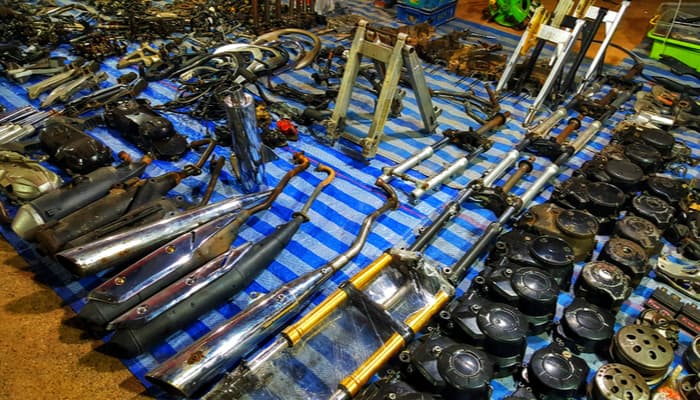When it comes to replacing or repairing motorcycle parts, bike owners have the choice of taking their vehicle to the dealer’s auto shop or an independent shop. Many motorcycle owners prefer working on their bike in their own garage. The choice of where you take your bike for repairs really boils down to the type of part you want.
If you take your motorcycle to the dealership for repairs, you will get OEM parts. And if you take your bike to an independent shop, you will most likely get aftermarket motorcycle parts. What is the difference? In this buying guide, we will discuss OEM vs aftermarket parts and talk about the pros and cons of each.
What Are OEM Parts?
OEM stands for Original Equipment Manufacturer. They are motorcycle parts and accessories made by the original motorcycle manufacturer, such as Honda, Yamaha, Harley Davidson, Ducati, and so on. Therefore, OEM motorcycle parts are brand new and original.
The Pros of OEM Motorcycle Parts
Peace of mind – For some, only using original parts is the key to keeping their motorcycle running smoothly. They even believe buying used motorcycle parts is better, as long as they are OEM.
If you’re happy with your motorcycle and trust the brand, taking your bike to the dealership for repairs for OEM parts can give you confidence. You don’t need to worry about performance or whether the part you are replacing will work. Because the dealership will simply replace the damaged or worn-out part with a brand new one made by the same manufacturer, you’re assured the same level of quality.
Backed with warranty – OEM parts typically come with a warranty, which explains why some buyers are willing to pay the extra cost. OEM manufacturers stand by their products, as well as their labor, and they guarantee that if the part doesn’t work within the warranty period, you can easily contact customer care and they will replace or repair it. But just like with a car warranty that dictates you are only covered as long as you use OEM car parts, using a non-OEM part as a replacement part for your motorcycle may void its warranty.
No need to assess compatibility – One of the biggest issues when it comes to buying parts and accessories for your bike is compatibility. Because the dealership will use the same part on your bike, there’s no reason to question whether the part will fit.
The Cons of OEM Motorcycle Parts
Costs more – OEM parts are typically more expensive than aftermarket parts. Market research shows that OEM parts can cost as much as 60% more than aftermarket parts. However, the difference in price tag has more to do with the brand than quality. For example, OEM parts and aftermarket parts may be made by the same manufacturer; but once the OEM parts bear the brand of the dealership, it suddenly comes with a higher price. For some, knowing that a part carries the dealership’s brand gives the bike more value.
Limited availability – Even if you know how to fix your own bike, choosing OEM parts typically means you would still have to go to the dealership to buy the part. There’s also the option of buying the parts online; however, those sellers are likely getting them from the dealership as well. This means you’re probably paying more because they will charge you for their services and shipping. If you were to go to an independent shop and request OEM parts, the mechanic will likely order from the dealership, which may mean it will take longer for your bike to be repaired, since you need to wait for the part to be delivered.
Not always better quality – If you think that OEM parts are always superior because they were made by the bike’s manufacturer, you would be wrong. Even the best brands have had issues with quality. In some cases, aftermarket parts are just as good as the original, or they may even be better than OEM parts. This is because aftermarket manufacturers reverse-engineer the part. And when they make the part, they may improve on its weaknesses and build a product that is better in quality than the original.
What Are Aftermarket Parts?
Aftermarket motorcycle parts are made by third party manufacturers that are not connected with the motorcycle brand. While they are not associated or authorized by the original brand to make parts for their bikes, there is nothing illegal about aftermarket parts. Aftermarket manufacturers don’t market motorcycle parts and accessories using the original part’s branding. The only time there will be legal problems is if the aftermarket part marketed itself as a product from the original motorcycle manufacturer.
The Pros of Aftermarket Motorcycle Parts
Better Availability – One of the most obvious aftermarket parts pros is availability. Aftermarket brands are generally easier to come by. There are many sellers that carry them at their physical stores. You can probably walk into any independent motorcycle shop, and they will carry an aftermarket part you need. You can also easily purchase them online.
Potentially better quality – Because the goal of some aftermarket replacement parts manufacturers is to make improvements on the original’s design, the quality of aftermarket parts can often be superior compared to the OEM version. High quality aftermarket parts may be made with better material, making them more durable, higher-performing, and longer-lasting than OEM products.
Less expensive – Not all aftermarket parts are created equal. Prices will vary by brand. However, aftermarket parts are generally cheaper than OEM because they don’t carry the brand name. Some would say aftermarket brands offer a balance between cost and quality.
Wider Variety – Aftermarket parts manufacturers don’t just improve on the original design; they may even produce the part in different materials and colors. Because of the wider selection that the aftermarket market offers, bike owners who customize their vehicles tend to prefer aftermarket parts. For example, Harley Davidson may only offer a certain motorcycle accessory in black, while an aftermarket manufacturer may offer it in a wide range of colors.
The Cons of Aftermarket Motorcycle Parts
Warranty Issues – Unlike OEM, many aftermarket motorcycle parts are sold without warranty. If you want a warranty, you may have to pay a higher price or an additional fee. Without a warranty, you may need to turn to a separate insurance company to ensure you are covered.
Potential Quality Issues – We mentioned that some aftermarket manufacturers produce their own version of a part but improve on the flaws of the original. However, this is not always the case. Some aftermarket parts may make cheap replicas of the original. Therefore, it’s key to purchase from an aftermarket manufacturer that you trust.
Compatibility Problems – Fitment data is a crucial aspect in the buying and selling of motorcycle parts. Fitment or compatibility refers to vehicle type and make/model/year.
The motorcycle parts marketplace is not much different than the automotive industry. There are also aftermarket car parts and OEM car parts. When you need your car or motorcycle repaired, you need to ensure the part you’ve purchased to replace the damaged part is compatible.
One of the biggest concerns of bike owners purchasing aftermarket motorcycle parts online is knowing for sure whether the part will fit their vehicle. This isn’t an issue when aftermarket parts manufacturers are specific about fitment data. Fitment data is rarely an issue when it comes to reliable aftermarket parts manufacturers.
Conclusion
Whether it’s an electrical component or a brake pad, when it comes to aftermarket vs OEM, it all boils down to preference. Each comes with its own compelling set of pros and cons. Because they vary in price and quality, it would be wise to compare and consider the advantages and disadvantages before purchasing.








